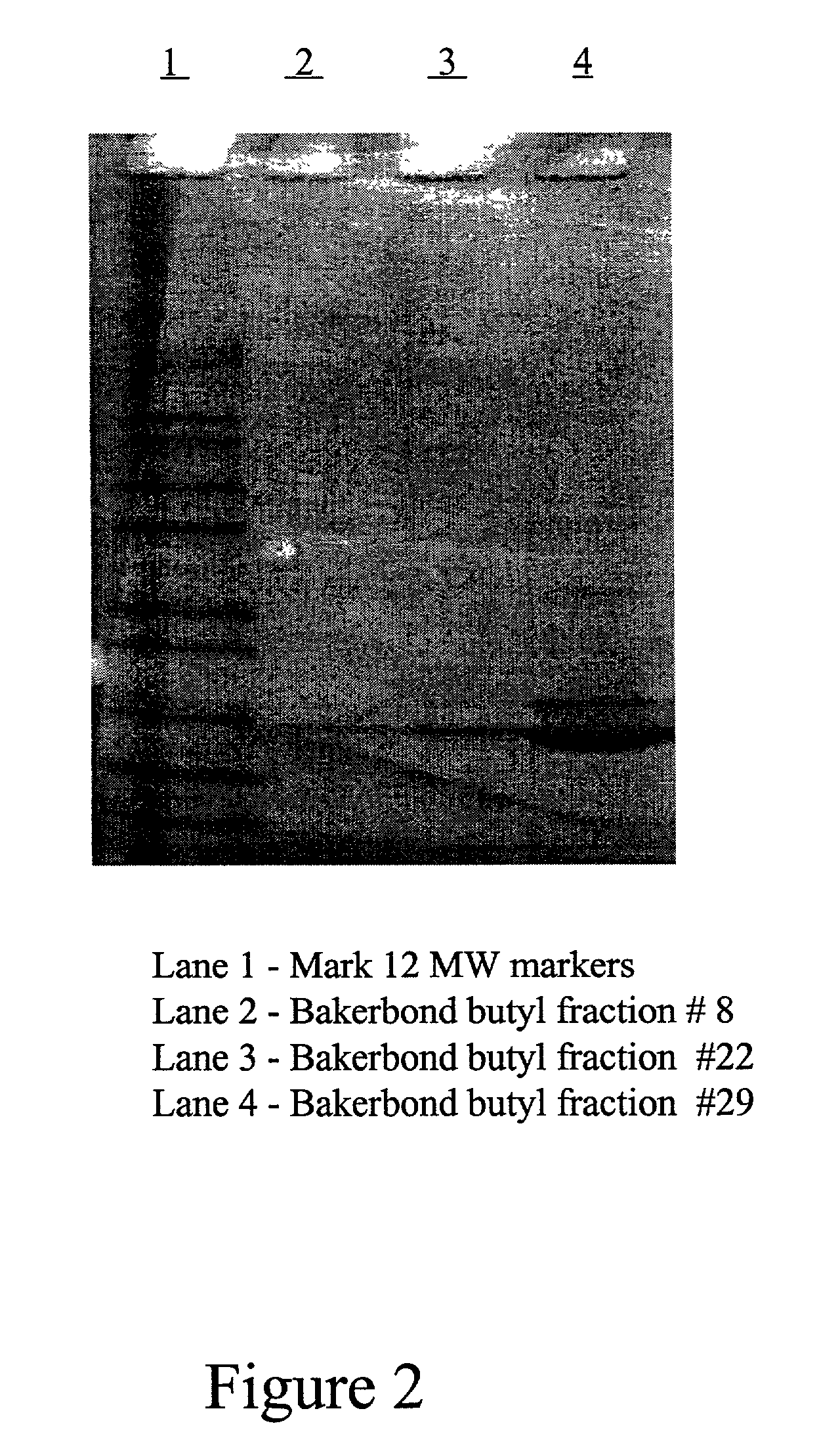Method for purification of molecules using unbranched terminal alkyldiols
a technology of unbranched terminal alkyldiol and purification method, which is applied in the direction of peptides, somatostatins, chemical/physical processes, etc., can solve the problems of high flammability, toxic solvents, and endanger the health of patients, and achieve the effect of less toxic and less denaturing
- Summary
- Abstract
- Description
- Claims
- Application Information
AI Technical Summary
Benefits of technology
Problems solved by technology
Method used
Image
Examples
example 1
6.1. Example 1
Baker Bond Butyl Experiments
[0079] Butyl experiments were performed on an AKTA column (Amersham Pharmacia Biotech, Piscataway, N.J.). Step and linear gradients were run to elute GHA. Gradient length and gradient slopes were adjusted according to the experiment. Effluents were monitored by UV absorbance at 280 nm. The buffer system consisted of 15 mM triethylamine phosphate ("TEAP") at pH 7.2 as buffer A and buffer B was 15 mM TEAP at pH 7.2 containing between 60% and 70% 1,6 hexanediol.
[0080] FIG. 1 shows the elution profile of GHA from a widepore butyl column (Mallinckrodt Baker Inc., Phillpsburg, N.J.) using 1,6 hexanediol as an eluant. The SDS-PAGE analysis of the eluant is shown in FIG. 2 (lanes 2-4). Lane 4 which corresponds to fraction 29 clearly contains GHA. Lane 2 and Lane 3 (Fractions 8 and 22, respectively) contain some GHA but to a much lesser extent than Lane 4. Fraction 29 correlates with the apex of the 280 nm absorbance peak. FIG. 3 is the C-4 RP-HPLC a...
example 2
6.2. Example 2
Small Scale Experiments with Methacrylate Columns CG71-M
[0081] A 10 mm.times.10 cm (8.0 ml) Amberchrom CG71-M column (TosoHaas, Montgomeryville, Pa.) was equilibrated at 2 ml / min in 15 mM TEAP, pH 7.2. A 27 ml aliquot of GHA (2.6 mg / ml, dissolved in 50 mM Tris, pH 7.2, 200 mM NaCl) was loaded onto the equilibrated CG71-M column and then washed with equilibration buffer. The column was eluted stepwise with hexanediol beginning with 32.5% hexanediol in 15 mM TEAP, pH 7.2 then with 49% hexanediol in 15 mM TEAP, pH 7.2 and 65% hexanediol in 15 mM TEAP, pH 7.2. The eluant was monitored by absorbance at 280 nm and collected fractions were analyzed by SDS-PAGE and RP-HPLC.
[0082] The chromatography results from the 8.0 ml Amberchrom CG71-M column are shown in FIG. 4. GHA was eluted by a step gradient of 32.5% hexanediol in TEAP, pH 7.2 with a yield of 98%. FIG. 5 shows SDS-PAGE analysis of the eluted protein. As can be seen in FIG. 5, lane 10, the eluted protein consists of pr...
example 4
6.4. Example 4
Screening Methacrylate Resins (CG71-M and CG71-C) and Styrene Divinylbenzene Resin (CG300-M)
[0085] Three columns containing Amberchrom CG71-M (TosoHaas, Montgomeryville, Pa.), Amberchrom CG71-C and Amberchrom CG300-M resin, (TosoHaas, Montgomeryville, Pa.) respectively were equilibrated in 15 mM TEAP, pH 7.2. Each column was loaded with 40 ml of diluted top phase material (prepared by two-phase extraction, using the procedure of Hayenga et al., U.S. patent application Ser. No. 09 / 307,549) which contained about 0.5 mg / ml GHA. The columns were loaded at 10 mg / ml. After loading, each column was washed with 15 mM TEAP, pH 7.2. A linear gradient of 0% to 65% hexanediol in 15 mM TEAP, pH 7.2. was used to elute GHA from the columns (about 20 column volumes of solvent were used). Effluent was monitored by absorbance at 280 mn and appropriate fractions were collected. Fractions were analyzed by C-4 RP-HPLC and SDS-PAGE.
[0086] It was decided to use the method of the present inve...
PUM
| Property | Measurement | Unit |
|---|---|---|
| diameter | aaaaa | aaaaa |
| diameter | aaaaa | aaaaa |
| diameter | aaaaa | aaaaa |
Abstract
Description
Claims
Application Information
 Login to View More
Login to View More - R&D
- Intellectual Property
- Life Sciences
- Materials
- Tech Scout
- Unparalleled Data Quality
- Higher Quality Content
- 60% Fewer Hallucinations
Browse by: Latest US Patents, China's latest patents, Technical Efficacy Thesaurus, Application Domain, Technology Topic, Popular Technical Reports.
© 2025 PatSnap. All rights reserved.Legal|Privacy policy|Modern Slavery Act Transparency Statement|Sitemap|About US| Contact US: help@patsnap.com



